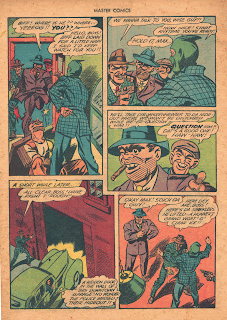The Vacuum Master
While this is an overall clever idea for a menace there are some contradictions. In Junior's first confrontation with Vacuum Master he thinks, "Hey, no voices! But naturally not! Air carries sound! There's not sound in a vacuum such as this!" On the last page CMJ tosses the big bomb into outer space and states. ""I'll shove it away from the Earth into space! Space is just a big vacuum itself, so the bomb belongs there!" There is another CMJ story where he actually talks in the vacuum of outer space. Art by Bud Thompson. The vacuum gimmick was used in a somewhat different context in an Adam Strange story "The Weapon that Swallowed Men!" (Mystery In Space #63, Nov 1960).
Monday, September 26, 2011
Sunday, September 11, 2011
Captain Marvel Jr #22 (The Necktie Party) Aug. 1944
The Necktie Party!
This is a fairly typical story about mob justice and taking the law into your own hands. CMJ gives a speech taking the would-be lynchers to task for not following the correct legal process. Other than for some spectacular rescues the Blue Boy's super powers were not needed. Perhaps the most interesting thing is we see Freddy as a cub reporter of sorts assisting "Livewire" Larry Davis. As with the previous story the uncredited art was probably provided by the Fawcett Art Dept.
(Will return in a couple of weeks. God Willing)
This is a fairly typical story about mob justice and taking the law into your own hands. CMJ gives a speech taking the would-be lynchers to task for not following the correct legal process. Other than for some spectacular rescues the Blue Boy's super powers were not needed. Perhaps the most interesting thing is we see Freddy as a cub reporter of sorts assisting "Livewire" Larry Davis. As with the previous story the uncredited art was probably provided by the Fawcett Art Dept.
(Will return in a couple of weeks. God Willing)
Saturday, September 10, 2011
Master Comics #45 (December 1943) Minute Man
Minute Man first appeared in Master Comics #9 (February 1941) beating his more famous counterpart Captain America by one month. However MLJ's Shield beat both of them as the first star spangled costumed patriotic superhero (Pep Comics, #1, January 1940), Minute Man was mildly successful as he got his own title for three issues (1941-1943). There is a sense in this yarn that the writer and artist are just going through the paces. While the artist produces dynamic layouts the plot and characterization is so thin that one wonders why Minute Man was given 13 pages— more that twice that of Bulletman. Any real enthusiasm for the character had long since departed. Minute Man had only four more Master Comics appearances before he was dropped in favor of Radar a trench-coated International spy fighter. The artist Phil Bard had a sort of gonzo Simon and Kirby style and even worked on Captain America as well as other strips for Fawcett and DC Comics. In the 1930s he did cartoons for communist publications like the New Masses and The Daily Worker.
Friday, September 9, 2011
Master Comics #45 (December 1943) Bulletman & Balbo
Bulletman was the most successful of Fawcett's second tier superheroes (after the Marvel Family). His zenith was during 1942 and early 1943. He not only appeared in Master Comics but also in his own title and America's Greatest Comics. However by the end of 1943 his strip was in rapid decline with the cancellation of the Bulletman comic (there was a short-lived revival of that title in 1946) and America's Greatest Comics. Perhaps it is indicative that Bulletman followed Hopalong Cassidy in this issue. Bulletman was canceled with issue #12 (February 1943). The first issue of Fawcett's Hopalong Cassidy was dated February 1943. The story in this issue of Master Comics is one of Bulletman's least interesting. For more on Bulletman see Men of Mystery #80 (AC Comics).
Balbo, the Boy Magician is also a pretty dull offering—definitely filler material. Perhaps the most interesting thing about the story is that the villain escapes at the end. Balbo lasted two more issues before he slipped into comic book limbo.
Balbo, the Boy Magician is also a pretty dull offering—definitely filler material. Perhaps the most interesting thing about the story is that the villain escapes at the end. Balbo lasted two more issues before he slipped into comic book limbo.
Subscribe to:
Posts (Atom)


















































